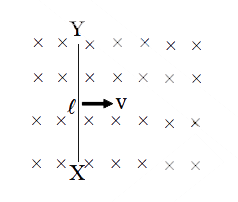A conducting wire of length l is placed on a rough horizontal surface, where a uniform horizontal magnetic field B perpendicular to the length of the wire exists. Least values of the forces required to move the rod when a current I is established in the rod are observed to be F1 and F2(<F1) for the two possible directions of the current through the rod, respectively. Find the weight of the rod and the coefficient of friction between the rod and the surface.
Changing the direction of current in the wire, we can change the normal reaction on the wire by the surface. In one case, magnetic force on the wire will be in upward direction while in the other case it will be in the downward direction.
Hence, normal reaction, N=mg±Bil
ffriction limiting=μ(mg±Bil) as F1>F2
F1=μ(mg+Bil).....(i)
And F2=μ(mg−Bil)....(ii)
From Eqs (i) and (ii), F1F2=mg+Bilmg−Bil
mg=Bil[F1+F2F1−F2].....(iii)
From Eqs (i) and (iii), we get μ=F1−F22Bil.
Topper's Solved these Questions
- BOOK - CENGAGE PHYSICSCHAPTER - MAGNETIC FIELD AND MAGNETIC FORCESEXERCISE - Solved Example25videos
MAGNETIC FIELD AND MAGNETIC FORCES
- BOOK - CENGAGE PHYSICSCHAPTER - MAGNETIC FIELD AND MAGNETIC FORCESEXERCISE - Exercise 1.122videos
MAGNETIC FIELD AND MAGNETIC FORCES
- BOOK - CENGAGE PHYSICSCHAPTER - KINETIC THEORYEXERCISE - Question Bank31videos
KINETIC THEORY
- BOOK - CENGAGE PHYSICSCHAPTER - Magnetism and MatterEXERCISE - Question Bank50videos
Magnetism and Matter
Similar Questions
A conducting cylinder of length L is placed on a rough horizontal floor. A horizontal magnetic field is applied perpendicular to the length of cylinder. F1 and F2 are the minimum forces required to move the cylinder for two possible directions of current, which can be passed through the cylinder. Calculate the coefficient of friction between the floor and the cylinder. Assume F1>F2.
View SolutionA metal rod of length l cuts across a uniform magnetic field B with a velocity v. If the resistance of the circuit of which the rod forms a part is r, then the force required to move the rod is
View Solution
Knowledge Check
- Question 1 - Select One
A conducting rod of length l is falling with a velocity v perpendicular to a uniform horizontal magnetic field B. The potential difference between the two ends will be
A2 BlvBBlvC12BlvD12Bl2v2 - Question 2 - Select One
A conducting rod of mass m and length l is placed over a smooth horizontal surface. A uniform magnetic field B is acting perpendicular to the rod. Charge q is suddenly passed through the rod and it acquires an initial velocity v on the surface, then q is equal to
A2mvblBBl2mvCmvblDBlv2m - Question 3 - Select One
A straight wire of length 1 m, and carrying a current of 1.8 A, is placed in a uniform magnetic field of induction 2T. If the magntic field is perpendicular to the length of the wire, then the force acting on the wire is
A1.8NB3.6NC0.9ND2.5N
A conducting wire of length and mass m is placed on a horizontal surface with its length along y direction. There exists a uniform magnetic field B along positive x direction. With wire carrying a current I in positive y direc- tion, the least value of force required to move it in x and y directions are F1 and F2. Now the direction of current in the wire is reversed and the value of two forces becomes F'1 and F'2. Find the ratio of forces F1:F2:F'1:F'2
 View Solution
View SolutionA uniform rod AB of mass m and length l is at rest on a smooth horizontal surface. An impulse J is applied to the end B perpendicular to the rod in horizontal direction. Speed of the point A of the rod after giving impulse is:
View SolutionA straight wire of length 0.5 metre and carrying a current of 1.2 ampere is placed in a uniform magnetic field of induction 2 tesla. If the magnetic field is perpendicular to the length of the wire , the force acting on the wire is
View SolutionA uniform rod of mass m, length l rests on a smooth horizontal surface. Rod is given a sharp horizontal impulse p perpendicular to the rod at a distance l/4 from the centre. The angular velocity of the rod will be
View SolutionA small conducting rod of length l, moves with a uniform velocity v in a uniform magnetic field B as shown in fig __
 View Solution
View Solution
